QuestionOur 5-year-old German shepherd is showing definite signs of aggression toward our 7-month-old female lab puppy. How can we curb her behavior and help her to accept the newest member of the "pack"?
AnswerYour concern about the older German Shepherd dominating the Younger female pup.
Your dogs are part of a Pack. A puppy's first pack leader is his mother. From birth, puppies learn how to be cooperative members of a pack oriented society. At about three or 4 months after they're weaned, they fall into the regular pack structure and take cues from the pack leader - YOU. Not their mother. When you are not around, the mother or older german shepherd then takes on the roll of a pack leader as she is second in command and disciplines and corrects the pack.
There could be a conflict in the way you lead as opposed to the way the older german shepherd leads. There is much to learn from a pack.
In nature, a pack leader makes rules and sticks to them - always correcting a violation of the rules. A pack couldn't survive without rules no matter what the species. In many human households, the rules, boundaries and limitations for the dog are unclear, or inconsistent if they exist at all.
Pack leaders always correct dogs that are misbehaving or not following the rules.
When the younger dog cowers and is down on the floor around the older dog, she is in a submissive position. When the Older dog stands over the other dog and nips her she is showing her dominance and correcting her behavior. This is quite common in a pack. It is the pack leader's way of teaching what is appropriate and what is not.
My Second in Command - corrects my younger dogs in my absence. The more I understand them, the more I understand how strict a pack leader is with it's pack. The more strict I become with them in order to become a good pack leader myself.
I have one pup that my pack leader tends to correct the most. She is the one that does her own thing and does not listen as readily when asked to comply.
When I let my dogs out and they are ready to come in, I tap on the window and they all come running and sit outside the back door waiting for me to let them in, but one... well she continues to play. The others get annoyed because this holds them up from coming in the house. I don't let them in until they are ALL sitting at the back door. Eventually the one will stop playing and come and sit. So I let them in. But the Pack leader will growl and nip and this pup to correct her behavior.
Another example of my second in command correcting this pup is at my mealtime. Pack leaders always eat first in the wild, get the choice food and the pack waits at a distance until the pack leader is finished before they can eat. A pack would never rush the pack leader while eating. I follow this in my household too. But the young pups want to rush me because they smell the food I am eating.
I correct my dogs by showing my dominance over them, looking them in the eye, leaning towards them, pointing at them, or gently moving them where I want them while is say a fast authoritative Shhh. Used consistently, my dogs know this is a correction and that I am asserting my authority over them.
At my mealtime I do this to let the pup know his behavior is not tolerated. If the pup won't listen, the second in command will also correct her behavior by showing dominance, growling or nipping the pup who won't listen.
There are times, when I think my second in command is being harsh on the young dog in my presence. As the pack leader, I assert my authority over her to remind her that I am in command now, not you. But I do need to ask myself why the older one was correcting the younger one. There is usually a good reason for it, and it usually means that it's something I did not correct the dog for myself.
My dogs are well balanced my second in command is also very loving and patient with the pups, playing with them, encouraging them to play ball, cuddling with them. Older dogs sometimes don't like all the energy of a young pup.
Sometimes even at play the dogs will growl and nip but they do not hurt each other. One of my pups loves to play growl with the Pack leader - they sing back and forth with each other and when I've had enough I ask them to be quiet. The Shhh Correction comes in handy at these times.
There is much to say about this, more than can be answered here. But it sounds like this is the case in your situation.
AGGRESSION
For assistance with a more aggressive dog I have answered this question previously and is included below
Previous Response dealing with Aggression.
Dogs are aggressive for many reasons not just one. Aggression in dogs comes from Lack of Exercise - Outlet for pent up energy, Lack of Boundaries, Lack of Trust, Confusion, Fear, Uncertainty, nervousness.
It's hard to know what to do if you don't understand where your dog is coming from. With a few changes in the way you relate to your dog, you will see very positive changes in short order. Your Dog is in fight mode when he is aggressive. He wants to protect either himself or you. This is not a good state to stay or live in and it will definitely lead to bigger and bigger problems.
Since you have not stated how you correct your dog I'll need to cover a number of areas. Your dog needs exercise and your dog needs to know the rules in dog speak. Your dog thinks he is the pack leader, and he needs you to be a pack leader he can trust and submit to.
UNDERSTAND YOUR DOG
The first thing you need to know is that dogs are at their happiest when they are in their submissive state. You're dog can't submit when he is in fight drive. Dogs can switch drives and its your job to help him do that. In the wild the pack leader sets the boundaries and the dogs eagerly comply. They know it is in their best interests to do so - their life depends on it. A pack leader immediately and appropriately, corrects inappropriate behavior and ensures that the fogs needs are met.
Dogs live in the present so they don't know what they are in trouble for when they get heck for something they did yesterday or an hour ago. If they are asked to come and they comply only to get into trouble they are afraid to come the next time because when they come they get into trouble. This is one example of how humans are inconsistent and unpredictable with their dogs.
BE A PACK LEADER
A pack leader is not someone that is mean to a dog, gets angry at the dog, yells at the dog, is inconsistent or unpredictable in behaviors. Dogs don't listen to that behavior they defend themselves from it. Dogs also sense anxiety, fear, frustration. A pack leader is confident and relaxed. A pack Leader provides sound structure, is consistent and can be trusted.
BE A PACK LEADER AND CONSISTENTLY WALK YOUR DOG
German Shepherds are high energy dogs. They need an outlet for all that energy. Walking is a must a minimum of 1.5 hours daily.
In the Wild dogs usually migrate each day looking for food walking mimics what they would naturally do in the wild.
BE A PACK LEADER - TEACH YOUR DOG TO HEEL BY YOUR SIDE.
Teaching a dog to heal is not as hard as most people think. The proper way to walk a dog is to have him walk on your left with a lose lead. Not behind, not pulling (you're the leader not him), not trying to chase other dogs, not barking at people or animals.
A very fast pack leader style to teach your dog. To heel, start by keeping the leash very short. Just long enough to keep him at your side. Consider using a a Halti and or a muzzle, for difficult dogs. A Halti allows you to move his head when you walk, keeping his attention in the right place. Walk tall, shoulders back and walk like you need to go somewhere (until the dog learns to stay by your side).
HOW TO CORRECT A DOG WHILE WALKING ON A LEAD
A dog that is pulling, sniffing, going the other way, barking at people, is aggressive etc. needs to be corrected.
3 Ways to Correct
1. Pull the lead towards you with a short fast jerk. Don't hurt the dog, don't yank so hard to create a neck injury. It is only to get his attention off what he is doing and on to you. And then relax your arm keeping it by your pant pocket. (if you want your dog to relax, you must relax! If you want your dog to be confident in You, be confident yourself!). The goal is to put your dog in a relaxed state of mind. He won't go there if you're not there. Put your thumb in your pocket to get used to where it should be. Hold the access lead in your right hand.
2. Adopt a verbal correction. I say Shhh very fast in an authoritative manner while quickly pulling the lead towards me. Used in a consistent manner my dog's understand what this means. I use this correction off and on lead. Off Lead I point at my dog, look him in the eye, Square off to him in a dominant position and say Shhh. I also gently move the dog to assist him to know what I want at times. I NEVER, YELL AT MY DOGS! I teach by example.
3. If the dog remains stubborn, I gently touch the dog with my foot. If your dog is on your left, use your right foot, bring it behind your left leg to touch the dog. I do not kick the dog or hurt the dog, I simply touch him to get his attention off of what he is doing and on to me. The Goal is to shift from one drive to the other and get is attention on me in order to place him in the relaxed submissive state.
Your dog won't submit if he is afraid. The Key is to get him to relax. I teach my dog to sit when I stop. And if stubborn I often stop until I have his complete attention.
The above corrections are designed to take the dog's attention off what he is doing to put his attention on you. The more he is corrected the more he will learn to pay attention to you and the less he will do the undesired behavior. Corrections must ONLY OCCUR AT THE MOMENT THE DOG ACTS. Not 10 minutes later, an hour later and so on. You can prevent pulling or aggressiveness by correcting just as he turns his head to pull or to become aggressive. You can prevent barking by correcting the moment he starts to bark.
CONSISTENCY is the key. Your dog will learn fast.
PRAISE YOUR DOG
Just as important is Praise. When your dog is doing what you want. Say Good Heel! Good Sit!. This gives your dog a word picture he can relate to desired behavior. Pet your Dog. Hug Him. Give him a treat when he is doing what you want.
If he knows you like it he'll continue the behavior. You must be consistent!
BE A PACK LEADER - FIND WAYS TO ENJOY YOUR DOG AND BURN OFF ENERGY
BIKE WITH YOUR DOG
Get an attachment for your bike so you can run your dog without him pulling you over. My dogs love bike rides. It burns off excess energy fast. I love it too, because I can go as fast as them.
RETRIEVE RATHER THAN TUG OF WAR.
Tug of War brings out the dog's aggressiveness. Its a good Idea not to play this with your dog until you have a handle on him. Walk to a field and get your dog to retrieve a ball. All that running is good for your dog and he will love you for it.
BE A GOOD PACK LEADER - SOCIALIZE YOUR DOG
Until a dog has been in a specific situation he does not always respond the way we want. For that reason the Dog needs to be exposed to many different things on a regular basis.
Have your dog sit or lay at your side and practice having friends walk in front of you and around you. Correct your dog immediately as as above for in appropriate behavior. The second your dog turns his head to act inappropriately correct him Don't let him follow through with the behavior. If you allow him to get into fight drive it will be harder to get him under control.
If your dog does not react inappropriately, but allows people to be near, Let your friends come up to him slowly. No Eye contact, hand out. Let him sniff their hand and look at them. Proper dog introductions, are first nose, then Eyes. If he reacts. Either your or someone has invaded his space too quickly and the people need to correct their behavior. If he reacts to a proper introduction, correct him as above. Consider going more slowly with him. If he accepts them. Praise him.
Practice in many situations. Someone at the door. Socialize your dog with children (not a first of course), with bikes, skateboards, busy streets, loud machinery, lawn mowers, blow dryers, blenders, to give him confidence on how to handle the situation.
Teach your dog to pay attention to you on walks and to avoid dogs and distractions. But also teach your dog proper behavior around other dogs and people, socialize him with your neighbors and friends and their dogs.
BE A PACK LEADER WHEN YOU FEED YOUR DOG.
Do NOT leave food out all day for your dog. Do not feed your dog until after his walk in the morning so he feels like he earned it as he would in the wild.
Ask your dog to sit. Do not give him his bowl until he sits and stays.
Put the bowl down and then tell him to go eat.
Leave the food out for 15 minutes. The remove the Bowl. This teaches your dog that Meal Time Is meal time. If he has to miss a few meals, he'll learn to eat when the bowl goes down.
Praise Your Dog For Good Behavior.
PRACTICE LEAVE IT COMMAND (Teaches Self Control. Teaches not to be aggressive around food also)
Practice a Leave It command by placing food on the floor. Hold his collar as he is lying down. When he goes for the food say "Leave It" and hold him back by his collar. When he moves back say Good Dog. Teach him to look at you and wait until you say OK before he gets the treat. Make noise, a clicking sound with your mouth to get his attention at first. I've taught all my dogs this and meal time is a piece of cake...Uh Kibble....
This translates into leaving things he shouldn't get into around the house....
HAPPY DOGS
A dog with rules and boundaries, structure, consistency and exercise are a happy dogs. Doing this teaches your dog how you will react too. The more he can anticipate your reaction the more he will want to please you.
In order to learn more about the pack structure and how to become a good pack leader Caesar Millan has written some great books on this subject that are available at my bookstore.
For more help on this subject. You might also want to check out the help or info section on my website.
Wishing you and your dogs much success.
Gallant German Shepherds
http://www.gallantshepherds.com

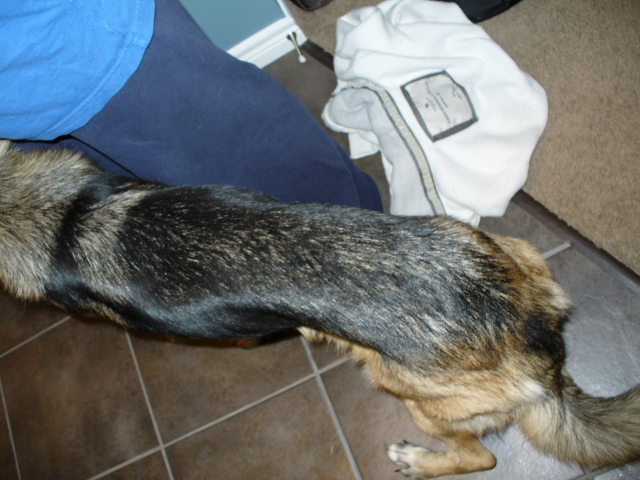 Very thin German Shepherd
Question
Sadie
Hi
We are having problems getting our
Very thin German Shepherd
Question
Sadie
Hi
We are having problems getting our
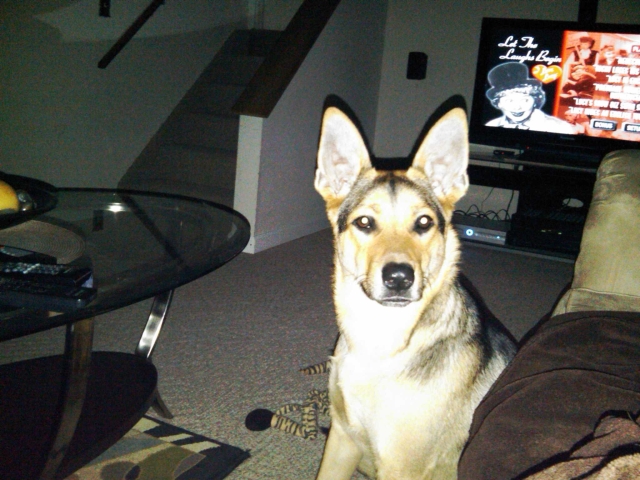 My German Shepherd Acts Scared
Question
Mannie
I have a male 1/2 German Shepherd 1/2 H
My German Shepherd Acts Scared
Question
Mannie
I have a male 1/2 German Shepherd 1/2 H
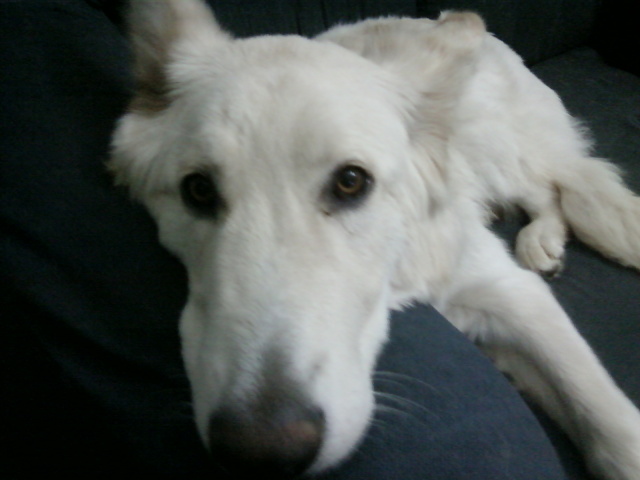 A traumatic experience
Question
Kelsie
Hi, we have two dogs and the second one
A traumatic experience
Question
Kelsie
Hi, we have two dogs and the second one
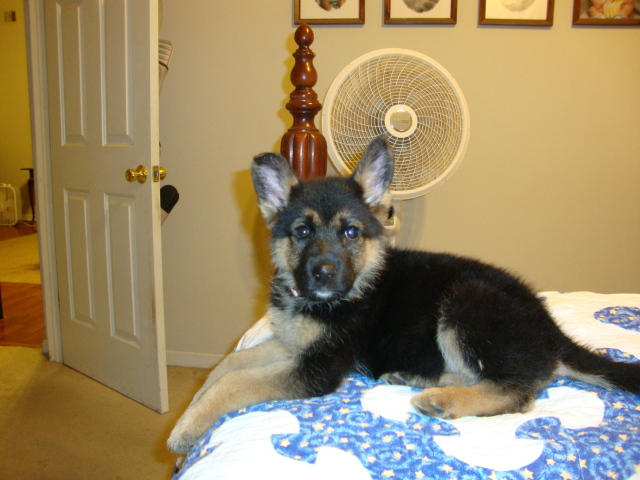 puppy wont eat
Question
ava 8weeksweeks
i have a purebred german sheph
puppy wont eat
Question
ava 8weeksweeks
i have a purebred german sheph
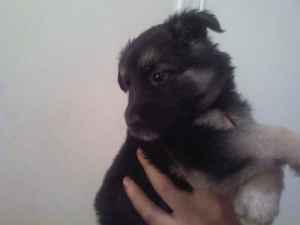 interested in adopting a puppy GSD.
Question
pic of the gsd puppy
Hey, im considering adopt
interested in adopting a puppy GSD.
Question
pic of the gsd puppy
Hey, im considering adopt